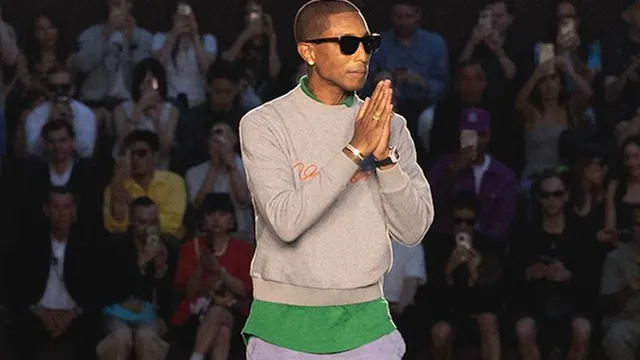
Pharrell Williams debuts Louis Vuitton's India-inspired collection at the Pompidou
2025-06-25 00:00- Pharrell Williams staged a Louis Vuitton fashion show at the Centre Pompidou, incorporating themes from India's rich cultural heritage.
- The collection featured vibrant colors, Indian-style garments, and innovative accessories that reflect a modern take on luxury fashion.
- This groundbreaking event showcases Louis Vuitton's adaptability and Williams' unique vision amid industry challenges.
Express your sentiment!
Insights
In a vibrant display of fashion and music, Pharrell Williams unveiled Louis Vuitton's Spring Summer 2026 collection at the Centre Pompidou in Paris. The show took place amidst a backdrop designed to resemble a life-size version of the traditional Indian game, 'Snakes and Ladders'. This thematic choice not only highlighted Williams' creative approach but also paid homage to India, signaling the country's rising influence in global fashion trends. Invited guests included an eclectic mix of contemporary cultural icons, showcasing the collection's relevance in today's luxury market. The collection's aesthetic featured a blend of Indian culture with contemporary fashion sensibilities. Highlights included Indian-style chunky sandals, blue preppy shirts, and pin-striped puffers that brought a Bollywood influence into the modern wardrobe. Patterns were inspired by Indian artisans, incorporating hand-beaded designs and motifs from local crafts into tailored silhouettes. The color palette reflected sun-faded hues, transforming traditional deep colors into softer pastels that echoed the Indian summer. Pharrell Williams' role as creative director for Louis Vuitton has become synonymous with merging music and fashion, emphasized in this showcase through a custom soundtrack. The event featured live performances joined by notable artists. This melding of artistic expression represents a significant shift in fashion shows, where music plays an integral role in the overall presentation of clothing. The show was not just a display but an experience that combined visual and auditory storytelling. Despite challenges faced by the fashion industry, including reports of declining sales for major brands, Williams' innovative approach presents a hopeful forecast. By incorporating elements that appeal to global sensibilities while also paying tribute to regional cultures, Williams places Louis Vuitton at the forefront of the evolving luxury market. The collection's reception indicates a potential resurgence for the brand and underscores the ideas of opportunity and creativity even amidst uncertainty in the global economy.
Contexts
Cultural themes in fashion shows have increasingly become a focal point of discussion and analysis in the realm of haute couture and ready-to-wear fashion. Within this vibrant medium, fashion designers and brands are not only showcasing clothing but are also expressing cultural narratives, social commentaries, and historical references. The integration of various cultural themes into runway presentations acts as a vehicle for dialogue and reflection on global issues. Designers draw inspiration from diverse cultures, utilizing textiles, patterns, and design elements that resonate deeply with audiences, thus fostering a greater understanding and appreciation of different heritages. The power of visual storytelling in these fashion narratives brings forth rich insights into identity, representation, and cultural hybridity, while also raising questions about appropriation and authenticity. Furthermore, the impact of global events and movements significantly influences the themes presented during fashion weeks. For instance, social movements advocating for equality and sustainability have permeated fashion discourse, prompting designers to incorporate these themes into their collections. This shift is notable in recent years, where fashion shows have increasingly showcased collections that reflect activism, social justice, and environmental awareness. Examples abound where collections not only address climate change or cultural preservation but also encourage the audience to engage with the underlying messages. Through captivating presentations that combine art, performance, and fashion, the runway becomes a stage for commentary and critique of contemporary societal issues. The role of digital media has also transformed the landscape of fashion shows, influencing how cultural themes are conveyed and perceived. Digital platforms allow for a broader reach, enabling designers to engage with diverse audiences and share the stories behind their collections. Social media channels facilitate vibrant discussions around the cultural implications of fashion, prompting consumers and critics alike to reflect on the narratives being presented. The rise of fashion influencers and digital-first brands has also democratized fashion, allowing for a fusion of grassroots cultural movements into mainstream fashion narratives, which is often evident in the collections featured on global stages. As fashion continues to evolve, the importance of cultural themes within fashion shows remains paramount. Designers are increasingly tasked with navigating complex cultural landscapes, making thoughtful and informed choices in their creative expressions. The responsibility of addressing and respecting the cultures that inspire fashion is significant, as it can either elevate cultural appreciation or perpetuate cultural stereotypes. Therefore, a delicate balance must be struck between creative expression and cultural sensitivity, ensuring that fashion serves not only as an aesthetic pursuit but also as a means of celebrating and honoring the rich tapestry of global cultures.